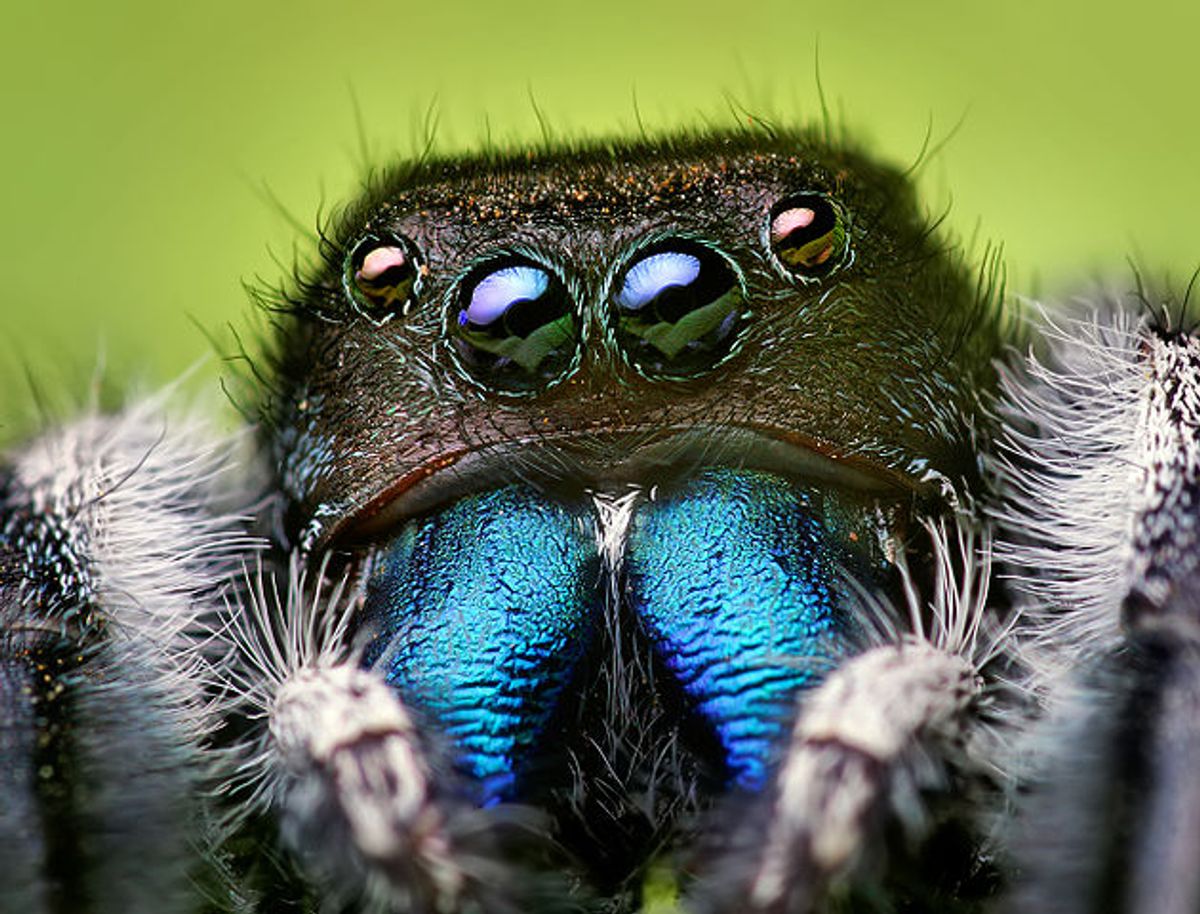Much of the recent research into jumping robots has used biology as an inspiration. UC Berkeley’s Tailbot, for example, uses a dinosaur-inspired actuated tail to help control its orientation while in mid-air. Other jumping species aren’t quite so lucky as to be equipped with tails, and have to find other ways of not tumbling helplessly mid-jump and face planting on landing.
One of the most prolific family of jumping animals is the jumping spider: there are something like 5,000 species around the world, and rather than building webs and just sitting around until something blunders into them, jumping spiders actively hunt their prey by using their excellent vision to spot lunch, chase it down, and pounce on it. Some jumping spiders, like the Phidippus audax pictured above, even steal lunch from other spiders (a behavior known as kleptoparasitism).
Jumping spiders might not build webs, but they can still produce silk, and they don’t like leaping into the void without a safety rope any more than you do. Before they jump, they tether themselves, and then release more silk as they fly, so that if they miss their target they can catch themselves and then climb back up to where they launched from. A few years ago, biologists took a closer look at the jumping spiders’ tether system, and realized that they used it for control as well as safety: by selectively applying tension to their safety tether, the spiders can control their pitch and make sure that they land right side up.
This combination of safety and control seems like a pretty good idea, right? So let’s teach robots to do it, too.
The first thing to address is why you’d want to use a tether when something like a tail works perfectly well for jumping stabilization. There are a few reasons; one is the physical safety that a tether gives you in that it can stop you from falling endlessly if you want it to. But more important, angular-momentum-based righting systems have to be either fast moving or relatively massive or both, otherwise they don’t work very well. A tethering system can be very small and light, since you only need to carry around the tether itself plus a very small actuator that can yank on it. You do have to deal with the tethering itself, and the system has a finite lifetime that’s limited by the amount of material that you carry around, but for situations where size and weight and power consumption are important, a tether is likely to be significantly more efficient.
Careful study of jumping spiders (which you can read here) has shown that immediately after jumping, the spiders will start to slowly rotate backwards. To compensate for this, they use an internal friction brake on their silk dragline to give themselves a bit of forward pitching momentum, reversing their motion to be able to land approximately parallel with the ground. If you’re so cruel as to cut their dragline, they’ll continue to rotate backwards and land upside-down.

Researchers from the University of Cape Town in South Africa built a robot called LEAP (Line-Equipped Autonomous Platform) to see if they could replicate the skills of the jumping spider. LEAP [right] is unlikely to remind you even a little bit of any sort of spider. It’s really just a piece of hardware (made mostly of LEGO Technic) that’s able to exert in-flight influence over an unspooling braided nylon line using a small DC motor. It’s not even a jumping robot, technically: it’s a launched robot, fired out of a catapult. The actual jumping part of all of this is (at least right now) not a significant part of the research, which is focused on tether effectiveness and control.
So how well does it work? About as well as it does for the spider, it turns out. Keeping a constant pitch is tricky, so the robot (and the spider) use periodic dragline braking to alter the direction in which they’re pitching such that they land properly. Depending on the initial jump velocity, this may happen once or twice over the course of the jump, but in both cases the robot was able to land right side up, at least as far as pitch is concerned. Dealing with roll and yaw is a bit trickier, and this particular version of the robot has no active control over these axes, although the researchers suggest that a different version of the robot with the ability to bend itself could add additional axes of control through the tether.
Future research will work on that non-planar motion, and also experiment with the application of non-constant forces on the tether, with the eventual goal of implementing closed-loop jump stabilization. The researchers will also explore alternate uses for the tether, like slowing the robot down just before it lands, or wrapping up bad guys and hanging them from lampposts until the cops show up.
“A Spider-Inspired Dragline Enables Aerial Pitch Righting in a Mobile Robot,” by Stacey Shield, Callen Fisher, and Amir Patel from the University of Cape Town in South Africa, was presented last week at IROS 2015 in Hamburg, Germany.
Evan Ackerman is a senior editor at IEEE Spectrum. Since 2007, he has written over 6,000 articles on robotics and technology. He has a degree in Martian geology and is excellent at playing bagpipes.


